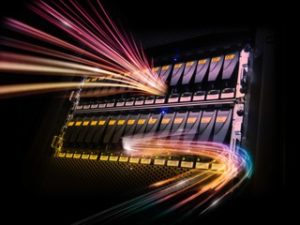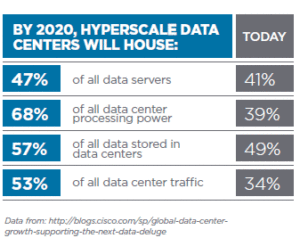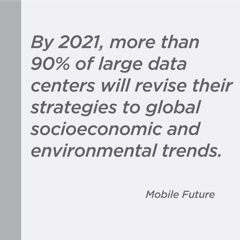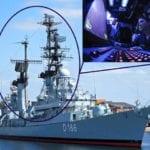The Impact of Evolving Data Center Models
Get ready for hyperscale: To support the increased needs and speeds of data centers, components on all levels need to operate without fail in a high-speed environment.
By Dave Helster, Director, System Architecture, TE Connectivity Data & Devices
Data is the center of everything. Now, more than ever before, we rely on data each and every day to perform basic and complex operations. When it comes to data centers, performance and continuous operation are critical for success because inaccessible data means loss of time, finances, and productivity.

A data center is the heart of an organization. Many large data centers can use as much electricity as a small town, and centralizing IT operations and equipment is a critical component to a company’s business strategy. Data centers store, manage, and disseminate data across a variety of devices, including computers, mobile phones, tablets, remote laptops, and equipment in virtually every market area. Data centers also house computer systems and associated components, such as telecommunications and storage systems, giving organizations the capability to control power, environments, and security all from one central module.
“Data is to this century what oil was to the last one: a driver of growth and change.” —The Economist
Data centers are not limited to physical structures; data centers have evolved into virtual infrastructures as well. Companies have the ability to run hybrid clouds, a combination of both types of data centers. This advance in structure has led to the transformed role and composition of data centers within an organization. During the first years of data center use, the technology was expected to be a 25-year commitment, yet it was known for inefficiencies in power and cooling, had only a little flexibility in cabling, and lacked mobility.
Today’s data centers are all about speed, performance, and efficiencies. Data centers have progressed from the one-size-fits-all mindset. Now a variety of architectures, configurations, and options are available to best fit individual business needs.
The Evolution of Hyperscale Data Centers
The word “hyperscale” is relatively new and refers to the facilities and provisioning that are required in distributed computing environments. The need to scale and grow systems quickly drove the evolution from a few servers to thousands. This type of computing is usually implemented in companies with a large focus on big data and cloud computing, and the need to handle sizable data transfers.

Hyperscale data center companies strike a balance between standardization and flexibility. Administrators also need to focus on innovation and seek a cost-effective infrastructure with faster refresh cycles, as well as the adaptability for the application or automation software to manage performance and failures. Software also plays a big role in driving operational efficiencies. For example, companies such as Facebook, Amazon, Google, and Microsoft have driven the definition and evolution of the hyperscale movement. At Facebook, there is one administrator for every 24,000 servers, in comparison to a traditional enterprise with one administrator per 300–700 servers.
Hyperscale computing is not just an American phenomenon; it is growing on a global scale with leading players around the world. In China, the parent company known as BAT includes Baidu, Alibaba, and Tencent. Although these companies may not be household names in the Americas or Europe, they are driving significant innovation across Asia. Baidu is a Chinese internet search tool and primarily controls most of the search market. Alibaba, an e-commerce tool, facilitates the sale of goods between online buyers and sellers through its extensive network of websites. Tencent, one of the largest, best-performing internet companies in the world, has services ranging from a social networking application to multiplayer online games. Like never before, companies across the globe are influencing and driving innovation for hyperscale computing.
The major forces driving hyperscale data centers from a technology perspective are the increased requirements for application performance and the growing need for reduction in operational expenditures and capital. Ever-increasing technology investments are also affecting hyperscale data centers. Many companies, not just hyperscale, are implementing the cloud as a partial or complete solution to help rapidly scale their infrastructure as business requirements skyrocket. In addition to hyperscale, there are a variety of related company types embracing these new technologies, from enterprises and service providers to governments.
Architecting Data Centers with Connectors
To support the increased needs and speeds of data centers, components on all levels — including basic power and data configurations to material innovations — need to operate without fail in a high-speed environment.
 One such connector that demonstrates the need for high performance requirements in data centers is TE Connectivity’s (TE’s) Silver 2.0 I/O connector, which delivers high performance, density, flexibility, and robustness per the SFF-TA-1002 specification. These super-slim, multi-lane connectors are rated up to 112G PAM-4 (56G NRZ) and are protocol-agnostic, meeting all current protocol performance requirements for PCIe Gen-3/-4 (8G and 16G), SAS-3/-4 (6G, 12G, and 24G), Ethernet (10G and 25G per lane), and InfiniBand (28G) protocols. They are also expected to meet performance for IEEE and OIF 56Gb/s, PCIe Gen-5, and SAS-5 and were selected for multiple industry standards, including Gen-Z, OCP, COBO, and EDSFF.
One such connector that demonstrates the need for high performance requirements in data centers is TE Connectivity’s (TE’s) Silver 2.0 I/O connector, which delivers high performance, density, flexibility, and robustness per the SFF-TA-1002 specification. These super-slim, multi-lane connectors are rated up to 112G PAM-4 (56G NRZ) and are protocol-agnostic, meeting all current protocol performance requirements for PCIe Gen-3/-4 (8G and 16G), SAS-3/-4 (6G, 12G, and 24G), Ethernet (10G and 25G per lane), and InfiniBand (28G) protocols. They are also expected to meet performance for IEEE and OIF 56Gb/s, PCIe Gen-5, and SAS-5 and were selected for multiple industry standards, including Gen-Z, OCP, COBO, and EDSFF.
Meeting the needs of power distribution within data centers is another challenge connectors and cables must address. TE’s Open Compute Project (OCP) bus bar connectors and cable assemblies offer a plug-and-play power solution designed to meet the OCP distribution architecture, providing a standardized platform for simple system designs. The connectors are fully compatible with OCP Open Rack V1 specifications and forward compatible with the Open Rack V2 specifications.
Continued Advancements for Data Center Growth
As data centers grow more complex, engineers turn to additional innovative solutions to meet the aggressive demands for higher data speeds and new power connections in the data center. Solutions like the TE’s Silver I/O connectors and Open Compute Project connectors demonstrate cutting-edge component design, and support the industry’s need to grow as data and power become more agile.
Dave Helster is director of systems architecture in TE Connectivity‘s Data & Devices division.





